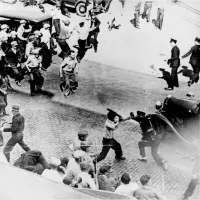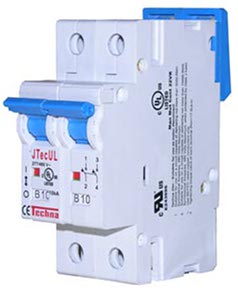A circuit breaker is an electrical safety device that protects circuits from overcurrent, preventing damage and fires. It interrupts current flow when it exceeds safe levels. Unlike fuses, which are single-use, circuit breakers can be reset, allowing for resumed operation after the overcurrent situation has been resolved. They are a fundamental component in electrical systems, ensuring safety and preventing equipment failure.
1924: Patent of Modern Miniature Circuit Breaker
In 1924, Brown, Boveri & Cie patented a modern miniature circuit breaker, similar to those in use today. Hugo Stotz, an engineer who sold his company to Brown, Boveri & Cie, was credited as the inventor on German patent 458392. This invention was the forerunner of the modern thermal-magnetic breaker.
1935: Circuit Breakers at Boulder Dam Project
By 1935, specially constructed circuit breakers used at the Boulder Dam project used eight series breaks and pressurized oil flow to interrupt faults of up to 2,500 MVA, in three AC cycles.
2000: Introduction of the Disconnecting Circuit Breaker (DCB)
In 2000, the disconnecting circuit breaker (DCB), a high-voltage circuit breaker modeled after the SF6-breaker, was introduced. The DCB integrates the disconnecting function in the breaking chamber, eliminating the need for separate disconnectors.
November 2011: Siemens Launched 1,200 kV Breakers
In November 2011, Siemens launched 1,200 kV circuit breakers.
2012: ABB Presents CO2 High-Voltage Breaker
In 2012, ABB presented a 75 kV high-voltage breaker that uses carbon dioxide as the medium to extinguish the arc, working on the same principles as an SF6 breaker. By switching from SF6 to CO2, CO2 emissions can be reduced by 10 tons during the product's life cycle.
2015: HVDC Circuit Breakers Research
As of 2015, high-voltage direct current (HVDC) circuit breakers are still a field of research to interconnect HVDC transmission systems.
Trending
53 minutes ago Ford's new EV strategy: Free chargers and perks to attract overseas buyers.

53 minutes ago Washington Senate passes bill ending youth "prison riot" charges; excludes juvenile facilities.

2 days ago Denny Hamlin Seeks Darlington Double After Martinsville Win, Secures Second Consecutive Cup Victory
2 hours ago NEC and JR East test face recognition on Shinkansen, eliminating Suica touch.

2 hours ago Kanye West Alleges Frank Ocean Opposed His Trump Support in 2016.

2 hours ago Federal Task Force Investigates Potential Fraud in Southern California Homelessness Funds Misuse.
Popular

Peter Navarro is an American economist and author known for...

Bruce Pearl is an American college basketball coach currently head...
The Nintendo Switch is a video game console developed by...

LeBron James nicknamed King James is a highly decorated American...
Facebook is a social media and networking service created in...

Michael Jordan also known as MJ is a celebrated American...
